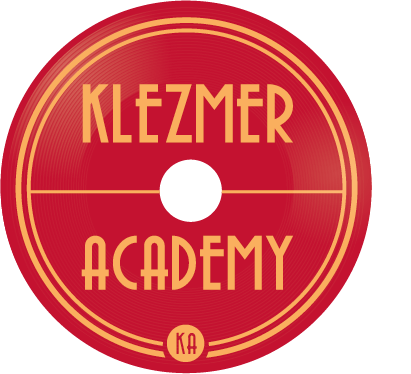Klezmer Academy Workshops
What Makes Yiddish Music Yiddish
Through a discussion of the three primary elements of music – melody, rhythm and harmony – this lecture/guided listening session explores both the universal Jewish elements in Yiddish music as well as those unique to Eastern European Jewish culture. From a discussion of the Jewish laws concerning instrumental music to the specifics of the modes and scales on which that music is based, this session will delve into the importance of music to the dissemination and celebration of yidishkayt. We’ll discuss traditional nusakh (prayer modes) and learn the melodic secrets of the Jewish calendar, and explore the ways in which traditional klezmer and modern jazz are not only not related, but fundamentally incompatible.
Jewish Vocal Sources of Klezmer Style
This lecture/guided listening workshop provides an overview of the Eastern European Jewish oral traditions that contributed all the major elements of klezmer style, including cantorial music, the rhythms of spoken Yiddish, and the music of the Chassidim. Length can be between 1 and 6 hours, depending on the detail required and the time available.
Klezmer Overview
Take a trip through the sonic world of the shtetl. This guided listening session examines the Jewish vocal sources of klezmer style, the modes that comprise traditional melody, as well as harmonic and rhythmic elements in traditional Yiddish instrumental music. For both musicians (instrumental and vocal) and non-musicians wishing to listen to the music with a more educated ear. Length can be between 1 and 6 hours, depending on the detail required and the time available.
Klezmer Hit Parade
Over its 30-year run, the dance bands and jam sessions of KlezKamp have rung with the sound of many tunes from a wide variety of sources, which have appeared and disappeared, and sometimes reappeared in cycles based on the interests of staff members and the discovery or reissue of original resources. Using both official and unofficial recordings, this session revisits the klezmer hits of the late 20th and early 21st century.
Klezmer From There (And Not Here)
If anyone has heard classic Yiddish 78 recordings, it would most probably have been from the more than 6,000 recorded in America. But klezmer was also recorded in Europe, South America, the Soviet Union and even Israel. This guided listening session shares these rarest of the rare klezmer 78s.
A Sonic Tour of the Mayrent Collection
From a rare recording of Sholom Aleichem reciting the monologue that forms the basis for “If I Were a Rich Man” and cantorial recordings reflecting the style of the mid-19th Century to klezmer recordings influenced by the American bandstand and Latin American rhythms, comic dialogues and Yiddish theater songs, this sonic tour through the Mayrent Collection of historic 78s will astonish and amaze.
KLEZMER COMPOSITION
Have you wanted to create your own klezmer tunes but wondered where to find inspiration? Have you been perplexed by when to put in a shout chorus? Have you composed tunes that don't sound quite right and wondered why? These questions and more will be explored in this practicum, which will be part analysis of tunes, both old and new, and part hands-on workshop. Session should be scheduled for at least 90 minutes.
European Gems from the Mayrent Collection
South American Gems from the Mayrent Collection
Soviet Recordings from the Mayrent Collection
Israeli Recordings from the Mayrent Collection
These hour-long sessions highlight Yiddish recordings from various parts of the world. All genres are represented.
Testimonials
“Sherry has a lovely way of clarifying the complexities of music theory.
She peppers her lessons with examples from her treasure trove of
historical recordings so that every class is filled with little “aha!”
moments. I took her “Klezmer Fundamentals” course twice because I enjoyed it so much and knew I would learn as much the second time around as the first. In both her playing and her teaching, she injects new life into the most beautiful and haunting tunes of the klezmer repertoire.”
Don't Ask Klezmer Band
“Mayrent’s well-reasoned analysis of Yiddish instrumental music is revealing. Throughout the class, she supports her observations with recordings from her extensive private collection of klezmer tunes froim different eras, including the oldest know recordings. She was the first teacher that I met that is able to clearly verbally express WHERE klezmer ornaments should be placed in a melodic line. Her knowledge of the lexicon of Yiddish music is extensive, and she has helped me to discover many aspects of Klezmer music which I had only an inkling about before taking her class. Her communication style is excellent, and she is able to get a skilled musician to change aspects of their playing without bruising anyone’s ego - a difficult task, in some cases!”
www.mazeltovkocktailhour.com
“I am writing to thank you for a wonderful musical and cultural experience in Grinnell yestierday. We brought you here hoping to appeal to new audiences, to present an event bridging music and religtous studies curricula, and to add a new dimension to the world music programs we offer at Grinnell College. Your workshops and performance accomplished these aims beautifully.
Sherry Mayrent’s presentation on “Vessels Of Song: The Origins And Development Of Klezmer Music” gave a well-organized and engaging 50-minute tour of disparate influences that shaped the music. The musical examples illuminated her points effectively. tt was a pleasure to learn about the music from such a knowledgeable and articulate performer.”
Chair, Dept of Music, Grinnell College
